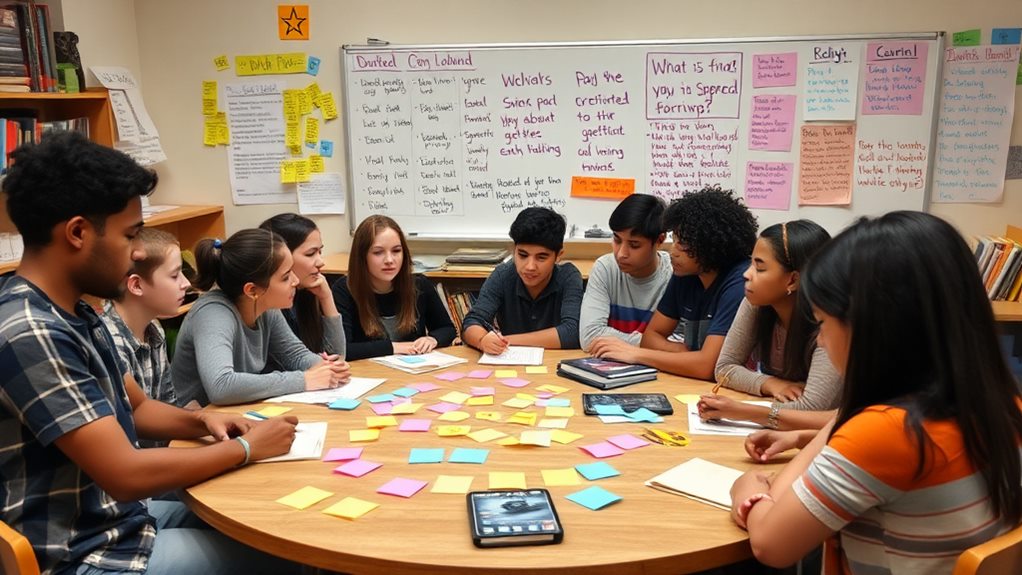
You might not realize it, but the questions you ask can fundamentally shape the nature of your conversations. Open-ended questions serve as catalysts for deeper engagement, pushing participants to explore their thoughts and emotions in ways that closed-ended queries cannot. This shift in dialogue can illuminate hidden insights and foster a sense of connection that typically remains elusive. Yet, as you consider the implications of this approach, one must ponder: what specific elements make an open-ended question truly effective, and how can you harness this power in your own interactions?
Definition of Open-Ended Questions

Open-ended questions are inquiries that invite expansive responses rather than simple yes-or-no answers, allowing for deeper exploration of thoughts and feelings. These questions typically begin with words like "how," "what," or "why," prompting the respondent to elaborate. You'll find that open-ended questions are essential in various contexts, such as interviews, education, and therapy, where understanding nuances is vital. In the domain of cognitive rehabilitation, for instance, open-ended questions can facilitate meaningful discussions that help identify specific cognitive impairments and elicit personal experiences, thereby tailoring the rehabilitation process to individual needs cognitive rehabilitation strategies.
When you ask an open-ended question, you engage the respondent's cognitive and emotional faculties, fostering a dialogue that can reveal layers of insight. This interaction isn't just about obtaining information; it's about creating a space where individuals can articulate their perspectives, experiences, and beliefs. By doing so, you enable a richer understanding of complex topics, as opposed to the superficiality often found in closed questions.
It's important to recognize that the structure of these inquiries shapes the quality of the responses. Open-ended questions encourage critical thinking and self-reflection, inviting individuals to navigate their thoughts more thoroughly. This dynamic interaction can lead to unexpected revelations, making it a powerful tool for anyone seeking to explore the intricacies of human experience.
Benefits of Open-Ended Questions
The advantages of using open-ended questions are multifaceted, greatly enhancing communication across various settings. By prompting expansive responses, you encourage deeper reflection and critical thinking. This approach invites individuals to articulate their thoughts, feelings, and experiences more thoroughly, fostering an environment of openness and trust. In contexts such as cognitive rehabilitation, open-ended questions can lead to significant improvements in understanding patients' needs and enhancing their recovery process.
You'll find that open-ended questions stimulate creativity and innovation. When you ask someone to elaborate rather than restrict their answers, it ignites the potential for new ideas and perspectives to emerge. This is particularly beneficial in collaborative environments, where diverse viewpoints can lead to more robust solutions.
Furthermore, these questions allow you to uncover underlying motivations and concerns, offering valuable insights into the respondent's mindset. This depth of understanding can be pivotal in areas like counseling, education, and management.
Additionally, open-ended questioning enhances engagement. It transforms passive listeners into active participants, which can lead to more meaningful discussions. Ultimately, when you embrace open-ended questions, you cultivate a dynamic dialogue that encourages exploration and discovery, enriching both the conversational experience and the relationship between parties involved.
Open-Ended vs. Closed-Ended Questions

When you consider the distinction between open-ended and closed-ended questions, it's essential to grasp their definitions and purposes. Each format carries distinct advantages and disadvantages that can considerably shape the quality and depth of your inquiry. For instance, open-ended questions can elicit more detailed responses and encourage expansive thinking, akin to exploring the impact of trauma on cognitive development. By exploring these differences, you can better tailor your questioning strategy to achieve your desired outcomes.
Definition and Purpose
Questions play an essential role in guiding conversations and eliciting information, and understanding the distinction between open-ended and closed-ended types is crucial for effective communication. Open-ended questions invite expansive responses, allowing you to explore the depth of a subject and engage in a more nuanced dialogue. For instance, in contexts like Cognitive Dissonance, asking, "What do you think about this topic?" encourages the respondent to share their thoughts, feelings, and experiences, which can lead to richer insights.
In contrast, closed-ended questions limit responses, typically yielding a binary or single-choice answer. For instance, asking, "Do you like this topic?" confines the dialogue and often stifles further exploration. This distinction serves a critical purpose depending on your communicative intent. If you aim to gather detailed information or foster discussion, open-ended questions are indispensable. On the other hand, if you need straightforward data or a quick confirmation, closed-ended questions may suffice. Consequently, knowing when to deploy each type can greatly enhance your conversational effectiveness, shaping the flow of discourse and revealing the complexities underlying human interaction.
Advantages and Disadvantages
Utilizing open-ended and closed-ended questions each brings distinct advantages and disadvantages, influencing how effectively you can gather information or foster dialogue. Open-ended questions invite expansive responses, encouraging deeper exploration of thoughts and feelings. They're ideal for eliciting nuanced perspectives, promoting creativity, and facilitating rich, qualitative data. However, they can also lead to ambiguity and lengthy responses that might stray from your intended focus.
On the other hand, closed-ended questions provide clarity and specificity, yielding quantifiable data swiftly. They're efficient for surveys or when you need straightforward answers, making it easier to analyze trends or patterns. Yet, the rigidity of closed-ended questions may stifle deeper insights, limiting the respondent's ability to express their thoughts fully.
In practice, the choice between these question types depends on your objectives. If you aim for breadth and depth of understanding, lean towards open-ended questions. Conversely, if efficiency and precision are paramount, closed-ended questions serve better. Balancing both can often yield the most thorough insight, allowing you to adapt your questioning strategy to the context and objectives of your inquiry.
Enhancing Communication Skills
Effective communication skills are essential for maneuvering both personal and professional landscapes, as they greatly influence the clarity of your interactions. When you master the art of communication, you create an environment where ideas flow freely and misunderstandings diminish. One fundamental aspect of enhancing these skills lies in your ability to ask open-ended questions, which invite deeper dialogue and exploration.
Consider these strategies to improve your communication:
- Practice active listening: Engage fully with the speaker, showing that you value their input.
- Use reflective responses: Summarize or paraphrase what you've heard to confirm understanding.
- Encourage elaboration: Ask follow-up questions that prompt the other person to expand on their thoughts.
- Be mindful of non-verbal cues: Your body language, eye contact, and tone can considerably impact the message you convey.
- Tailor your language: Adapt your vocabulary and style to suit your audience, ensuring clarity and relatability.
Applications in Education

In the domain of education, the ability to ask open-ended questions transforms the learning experience, fostering critical thinking and deeper understanding among students. These questions invite students to explore complex ideas, encouraging them to articulate their thoughts and engage in meaningful dialogue. By creating a space where students feel comfortable expressing their opinions, you enable them to analyze concepts from multiple perspectives.
Open-ended questions also challenge students to synthesize information, moving beyond rote memorization to higher-order thinking. For instance, instead of merely recalling facts, students learn to evaluate evidence, draw connections, and develop their own interpretations. This process not only enhances their cognitive skills but also nurtures their emotional intelligence as they navigate discussions with peers.
Furthermore, employing open-ended questions can improve classroom dynamics. They promote collaboration and respect, as students learn to listen actively and consider viewpoints different from their own. As you integrate these questions into your instructional practices, you shift the focus from teacher-centered to student-centered learning, ultimately cultivating a classroom environment that values inquiry and exploration. In this way, open-ended questions serve as an essential tool in shaping the future of education.
Role in Research and Surveys
When you consider the role of open-ended questions in research and surveys, you'll recognize their capacity to enhance data collection by allowing participants to express thoughts beyond predefined options. This unstructured format not only captures richer information but also promotes deeper insights into respondents' perspectives and motivations. Ultimately, these questions serve as an essential tool in uncovering complexities that closed-ended formats often overlook.
Enhancing Data Collection
Open-ended questions play an essential role in enhancing data collection processes within research and surveys. By encouraging participants to express their thoughts freely, these questions yield richer, more nuanced data than closed-ended alternatives. When you design your surveys, consider how open-ended questions can facilitate deeper understanding and engagement.
Here are some benefits of using open-ended questions in your data collection:
- Flexibility: Respondents can provide answers that reflect their true feelings without being confined to predetermined options.
- Depth: You'll gather detailed insights that reveal the complexities of participant experiences or opinions.
- Creativity: Participants are often able to articulate unique perspectives that could lead to innovative ideas or solutions.
- Contextualization: Open-ended responses can provide context that helps you interpret quantitative data more effectively.
- Engagement: You may find that participants feel more invested in the survey process when they can express themselves more freely.
Incorporating open-ended questions thoughtfully can greatly enhance the richness of your data, allowing for a more thorough analysis of the subject matter. You'll be better equipped to draw meaningful conclusions and inform future research directions.
Promoting Deeper Insights
Utilizing open-ended questions within research and surveys greatly fosters deeper insights, allowing you to explore participant perspectives in a multifaceted manner. These questions invite respondents to articulate their thoughts, feelings, and experiences without the constraints of predetermined answers. This freedom encourages a richer narrative, revealing complexities that closed questions often overlook.
When you employ open-ended inquiries, you're not just collecting data; you're unlocking the potential for transformative understanding. Participants can disclose underlying motivations, beliefs, and contextual factors that shape their responses. This qualitative depth often leads to unexpected themes or patterns, enriching your analysis and offering a more robust framework for interpretation.
Moreover, the iterative process of refining these questions based on initial responses can enhance clarity and relevance. As you engage in active listening, you're able to adapt your approach, tailoring subsequent questions to probe deeper into emerging insights. This dynamic interaction creates a more engaging experience for both you and the respondents, fostering trust and openness. By incorporating clarifying questions examples during the conversation, you demonstrate a genuine interest in understanding their perspective, which further strengthens the connection. These questions not only help to resolve ambiguities but also encourage respondents to elaborate, enriching the depth of the dialogue. The result is a collaborative exchange that yields more meaningful and actionable insights.
In essence, promoting deeper insights through open-ended questions not only enhances the quality of your research but also cultivates a richer understanding of the human experience, paving the way for more informed decision-making and strategic planning.
Tips for Crafting Open-Ended Questions

Crafting effective open-ended questions requires a nuanced understanding of language and intent. You need to evaluate the context and the responses you aim to elicit. Here are some practical tips to enhance your questioning technique:
- Focus on "how" and "why": These words naturally invite deeper exploration, prompting respondents to elaborate on their thoughts.
- Avoid leading questions: Steer clear of any phrasing that suggests a desired answer; this maintains the integrity of the response.
- Be specific yet flexible: Frame your questions to guide the conversation while allowing room for unexpected insights.
- Encourage reflection: Use questions that prompt the responder to think critically about their experiences, fostering richer dialogue.
- Listen actively: Your follow-up questions should be informed by the answers given, creating a dynamic exchange that builds on initial responses.
Examples of Effective Questions
Effective questions serve as the backbone of meaningful conversations, allowing for a depth of understanding that closed questions often fail to achieve. Consider the difference between asking, "What did you think of the presentation?" versus "Did you like the presentation?" The former invites a nuanced response, prompting the individual to articulate their thoughts and feelings in detail.
Similarly, questions like "How did you arrive at that conclusion?" encourage critical thinking and self-reflection, fostering a richer dialogue. These inquiries don't just gather information; they stimulate exploration and insight. When you ask, "What challenges did you face in this project?" you open the door for the respondent to share experiences, thoughts, and emotions, creating a more layered conversation.
Moreover, you might ask, "In what ways do you believe this experience will influence your future decisions?" This not only reveals the respondent's perspective but also establishes a connection between past experiences and future implications, enhancing the dialogue's depth. By utilizing such effective questions, you elevate the conversation, transforming it from a mere exchange of information into a profound exploration of ideas and feelings.
Encouraging Deeper Conversations

The key to fostering deeper conversations lies in your ability to create an environment where individuals feel safe to share their thoughts and vulnerabilities. When you establish this atmosphere, you encourage others to engage more meaningfully, allowing for richer dialogue. It's essential to be attentive to your conversational partner, demonstrating genuine interest in their perspectives.
To achieve this, consider employing the following strategies:
- Active listening: Show that you're fully engaged, nodding or responding appropriately to affirm their feelings.
- Empathy: Validate their emotions, making it clear that their experiences matter.
- Open-ended inquiries: Formulate questions that invite elaboration, steering clear of yes-or-no responses.
- Non-verbal cues: Maintain eye contact or use open body language to convey your receptiveness.
- Patience: Allow pauses in the conversation; these moments of silence often lead to deeper reflections.
Read The Next Blog Post –
Incorporating open-ended questions into your dialogues can transform conversations into boundless explorations of thought and emotion. These questions don't just scratch the surface; they release a torrent of insights that can reshape understanding and relationships. By mastering the art of crafting these inquiries, you're not merely asking questions—you're inviting a symphony of voices to contribute to the dialogue. Ultimately, the ability to engage deeply through open-ended questions can elevate communication to unprecedented heights, fostering genuine connections.














